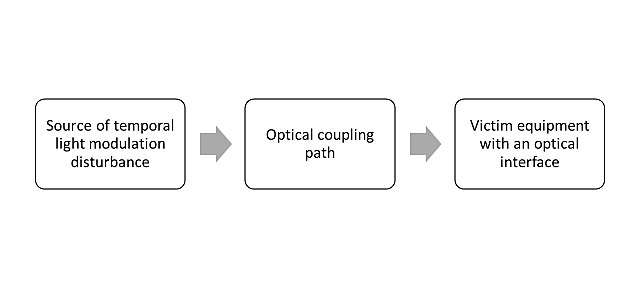Temporal light interference
Temporal light interference (TLI) is an unacceptable degradation of the performance of an equipment or system that has an optical input for its intended functioning and is caused by a temporal light modulation disturbance. A temporal light modulation (TLM) disturbance may be either an intentional or unintentional temporal light modulation (TLM) of lighting equipment such as luminaires or lamps. Examples of equipment that can be interfered are barcode scanners, cameras and test equipment.
NOTE – Temporal light modulations may also annoy human beings. In general, undesired effects in the visual perception of a human observer induced by light intensity fluctuations are called Temporal Light Artefacts (TLAs).[1]

Root causes of TLI
Temporal light modulation disturbances may arise from fluctuations of the light intensity of lighting equipment. Light emitted from lighting equipment such as luminaires and lamps may vary in strength as function of time, either intentionally or unintentionally (Figure 1). Generally, the light output of lighting equipment has unintentional residual light level modulations due to the lighting equipment itself. The magnitude, shape, periodicity and frequency of the TLM depends on many factors such as the type of light source, the electrical mains-supply frequency, the driver or ballast technology and type of light regulation technology applied (e.g. pulse-width modulation). Conventional incandescent type of lighting equipment typically has a moderate residual light modulation (10%- 20% modulation depth) with a modulation frequency which is twice the mains frequency. LED-type of lighting equipment, because they are semiconductor devices, respond much more rapidly to variations in the input signal than the conventional light sources. Therefore, LED light sources are also much more sensitive to fluctuations in the input current, and reproduce those current fluctuations in the light output, potentially leading to TLI. Furthermore, external factors such as incompatibility with dimmers or presence of mains-supply voltage fluctuations (power-line flicker) play a role and may cause additional temporal light modulations.
TLMs can be designed-in fluctuations from the electronic driver because of application of certain driver or light-regulation technologies. For example, AC-fed drivers or application of pulse-width modulation for light-level regulation cause a fairly high magnitude of modulation. However, LED drivers can also be designed to reduce the residual fluctuations in the current to the LEDs to limit the risk of TLI in specific applications.
Sometimes also intentional light variations are applied, for instance for visible light communication.
Potential victims of TLI
Equipment having an optical interface (Figure 1), that potentially may be interfered by TLM disturbances include:
- Film cameras, both analog and digital
- Smartphone cameras
- Security cameras
- Professional (television) camera’s, including high definition camera with super slow motion
- Laser beam-based barcode scanners
- Barcode scanners
- Pulse oximeters
- Infrared remote controls
- Systems for visible light communications
Each of this equipment have an optical interface for their functioning but they employ very different mechanisms, principles and restrictions to process the incoming light. Therefore, there is also a large variety of interference mechanisms. Consequently, there is not a single and simple metric that describes the level of degradation or malfunction of each of these type of equipment.
Examples of victims of temporal light interference
Visible Light Communication (VLC)
Visible light communication typically uses a common LED light source that is used for illumination and adds a small level of modulation on the DC-light level to transfer data. The receiver can be a specific device using a photodiode as detector, but it is often also a common smartphone camera. Various pulse modulation techniques and data rates can be applied depending on the function of the VLC system. TLM disturbances from sunlight or other ambient lighting can cause interference of the VLC system[2]. VLC systems generally apply specific coding and modulation techniques to achieve robustness against common TLM disturbances.
Barcode scanners
Barcode scanners are widely used, for instance to improve the efficiency in processing products and clients, such as super market check-out counters, hospital check in, parcel tracking and industrial production statistics. The use of linear (1D) and matrix (2D) barcodes is widespread. TLMs from lighting equipment located in the neighbourhood where barcode scanners are applied can cause TLI[3].
See also
References
- ↑ CIE TN 006:2016, Visual Aspects of Time-Modulated Lighting Systems – Definitions and Measurement Models (pdf).
- ↑ Latif Ullah Khan, Visible light communication: applications, architecture, standardization and research challenges, Digital Communications and Networks 3 (2017) 78–88.
- ↑ X. Deng et al, Performance of barcode scanner using peak detection with interference from LED lamps, 2015 IEEE Symposium on Communications and Vehicular Technology in the Benelux (SCVT), 24-24 Nov. 2015